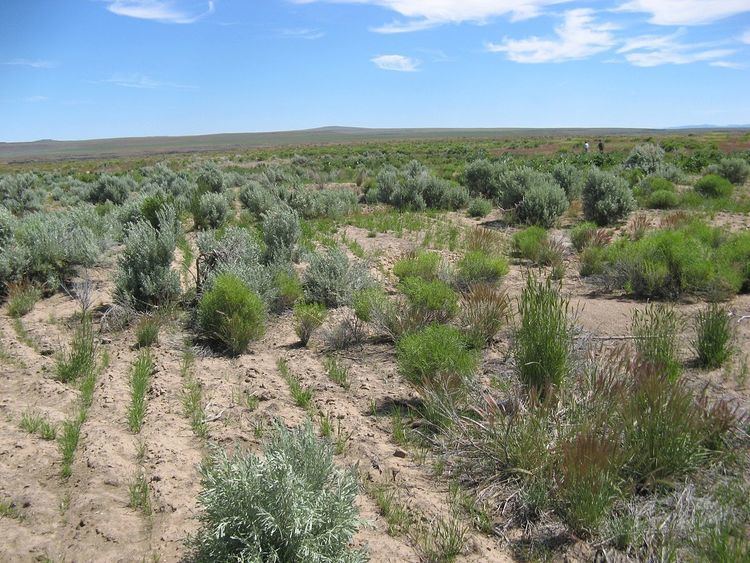 | ||
Ecologically-based invasive plant management (EBIPM) is a decision-making framework to improve the management of invasive plant species. When land managers are faced with infestations of invasive plants, a step by step framework to develop integrated management plans will improve their success at managing these plants. EBIPM is founded on the principles of ecology to manage invasive weed infesations and restore landscapes. The framework combines an ecosystem health assessment (Rangeland Health Assessment),a method to recognize how ecological processes affect causes of succession, ecological principles to guide the choices of tools and strategies to manage invasive plants and how to use adaptive management to generate a step-by-step decision model. The focus of EBIPM is to encourage managers to move away from simply killing the weeds and move toward management efforts that repair the underlying causes of invasion.
Contents
- Background
- Site Availability
- Species Availability
- Species Performance
- Steps
- Step 1 Complete a Rangeland Health Assessment
- Step 2 Identify Causes of Invasion and Associated Processes Not Functioning
- Step 3 Use Principles to Guide Decision Making
- Step 4 Choose Appropriate Tools and Strategies Based on Principles
- Step 5 Design and Execute a Plan Using Adaptive Management
- Associated EBIPM Videos
- References
EBIPM guides users through a 5-step process that begins with (step 1) an assessment of rangeland health to (step 2) determine why invasive species are present and what ecological processes are in need of repair. Managers can then (step 3) use ecological principles as targets to (step 4) choose the appropriate tools and strategies that will give them the best chances of successful and lasting results. The final step in the EBIPM process is to use adaptive management to design and implement a management plan.
Background
Land managers have historically used one or more of a number of strategies to treat rangelands dominated by invasive plants. Treatments may have included the use of herbicides, targeted grazing, seeding, controlled burning, biological controls, and any number of other rangeland management treatments. The problem with simply applying treatments is that, while initially weeds are controlled, the treatment does not fix the underlying cause of the problem and the invasive species, more often than not, grow again within a short period of time. The main reason for re-occurring weed infestations is that just applying treatments to control the weeds will likely have little-to-no influence on the ecological processes driving plant community change. The EBIPM framework employs ecological principles and the practices land managers have experience in using to mend actual ecological processes that are in disrepair. This strategy has proven to provide more successful and sustainable invasive plant management.EBIPM is based on ecological succession which was originally theorized by Frederic Clements and explains the concept of plant community change over time. Steward T. A. Pickett furthered the theory into successional management by developing a hierarchical model that includes the causes for plant community change, the controlling ecological processes, and their modifying factors. This model for successional management proposes three general causes of plant community change: site availability, species availability, and species performance.Site Availability
Site availability refers primarily to the availability of safe sites, or open niches, in the soil profile Safe sites, spots in the soil where a seed can germinate, emerge, establish, and flourish, are created through the process of disturbance, which is a temporary variation in the typical environmental conditions which often significantly affects and alters an ecosystem. Examples of disturbance include human disruption such as recreation, construction, or fire and it also occurs naturally through wildfire, flood, insect infestation, animal activity and other processes including variations in weather. Disturbances create openings for new or different plants which changes the natural succession of a plant community. Disturbance also lessens the competitive intensity between plants, changes conditions in the environment, and alters the supply rates of resources. Understanding site availability creates an opportunity for land managers to direct plant communities in a desired direction by manipulating disturbances to favor desired species. Applying ecological principles related to the process of disturbance can significantly impact and promote germination, establishment, and growth of native and desired species over invasive species.Species Availability
Species availability relates directly to the ecological processes of reproduction and dispersal, in other words, the availability of species through propagules either present in the soil seedbank or brought in by dispersal Essentially, species availability is the presence and establishment of various species. Seeds have developed a number of adaptations and are dispersed through various methods including wind, water, barbs, hooks, and awns that stick to animals and clothing, are carried in the wind or water...etc.Typically, invasive species produce more seeds relative to desired native species often giving the invasive species a competitive advantage. Managers can shift competitive balance back to desired or native species by increasing their reproductive capacity and density (adding seeds...seeding treatment), which can lead to higher densities of desired species. This is often enough for desired plants to swing the competitive balance back to their favor.Species Performance
Species Performance is how well a given species can perform in diverse environmental conditions based on a range of ecological processes including a species' ability to capture and use resources to survive and increase or spread in the environment despite competition, stress, and interference.The factors defining a given species' ability to survive and thrive in a number of different environmental conditions are:- resource availability and a species' ability to acquire and utilize those resources
- response to environment or a plant's ability adapt to changes in environmental conditions (also called ecophysiological plant traits)
- life strategy or a plant's life history strategy and the associated trade-offs influencing the survival or death of a species
- stress and the ability of a species to either avoid or tolerate stress, and
- interference or the level at which a plant is influenced by nearby plants of differing species.
